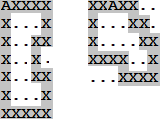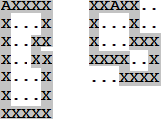ICPC ECNA 2016 H - Vin Diagrams
View as PDFICPC East Central NA Regional Contest 2016, Problem H
Venn diagrams were invented by the great logician John Venn as a way of categorizing elements belonging to different sets. Given two sets
Figure H.1
One of John's biggest fans was his grandson, Vin Vaughn Venn. Vin was inspired by his grandfather's diagrams, but Vin was a very creative individual. Simple overlapping circles struck Vin as too boring of a way to visualize the sometimes messy intersections of categories, so he set out to make his grandfather's diagrams more interesting. Just like Venn diagrams, Vin diagrams are used as a way of categorizing elements belonging to different sets
In this problem, Vin diagrams will be laid out on a grid. Each set representation is a loop of X characters, with one X in each loop replaced by an A or B to identify the loop. All empty positions (both inside and outside of the loops) are represented by period (.) characters, and the set of positions inside a loop is contiguous. Each loop character touches exactly two other loop characters either vertically or horizontally. Loops do not self-intersect, and other than the allowed horizontal/vertical paths and right angle connections, different parts of the loop do not touch (see Figures H.2 and H.3 below).

Figure H.2: Two legal loops |

Figure H.3: Two illegal loops |
Loops . positions around the intersection). No loop makes a right angle turn at an intersection point but always flows straight through the intersection, either vertically or horizontally. An example of legally intersecting loops is shown in Figure H.5.

Figure H.4: Intersection point and surrounding positions |

Figure H.5: Legally intersecting loops |
Input Specification
The input starts with two integers .) character. The loop labels A and B are placed somewhere around the loops' perimeters at non-intersection positions and are never on the same loop.
Output Specification
Display, in order, the area of the Vin diagram exclusive to set .) it encloses.
Sample Input 1
7 7
AXXXX..
X...X..
X.XXXXX
X.X.X.X
XXXXX.X
..X...X
..XXXXBSample Output 1
5 5 1Sample Input 2
11 13
XXXXXXA......
X.....X......
X..XXXXXXXXX.
X..X..X....X.
X..X..XXX..XX
X..B....X...X
X..X.XXXX...X
X..X.X......X
XX.XXXXXX...X
.X...X..X.XXX
.XXXXX..XXX..Sample Output 2
21 22 10
Comments